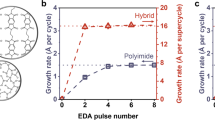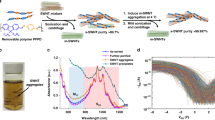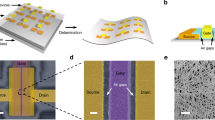Abstract
Carbon nanotube thin-film transistors1 are expected to enable the fabrication of high-performance2, flexible3 and transparent4 devices using relatively simple techniques. However, as-grown nanotube networks usually contain both metallic and semiconducting nanotubes, which leads to a trade-off between charge-carrier mobility (which increases with greater metallic tube content) and on/off ratio (which decreases)5. Many approaches to separating metallic nanotubes from semiconducting nanotubes have been investigated6,7,8,9,10,11, but most lead to contamination and shortening of the nanotubes, thus reducing performance. Here, we report the fabrication of high-performance thin-film transistors and integrated circuits on flexible and transparent substrates using floating-catalyst chemical vapour deposition followed by a simple gas-phase filtration and transfer process. The resulting nanotube network has a well-controlled density and a unique morphology, consisting of long (~10 µm) nanotubes connected by low-resistance Y-shaped junctions. The transistors simultaneously demonstrate a mobility of 35 cm2 V–1 s–1 and an on/off ratio of 6 × 106. We also demonstrate flexible integrated circuits, including a 21-stage ring oscillator and master–slave delay flip-flops that are capable of sequential logic. Our fabrication procedure should prove to be scalable, for example, by using high-throughput printing techniques.
This is a preview of subscription content, access via your institution
Access options
Subscribe to this journal
Receive 12 print issues and online access
$259.00 per year
only $21.58 per issue
Buy this article
- Purchase on Springer Link
- Instant access to full article PDF
Prices may be subject to local taxes which are calculated during checkout





Similar content being viewed by others
References
Jorio, A., Dresselhaus, M. S. & Dresselhaus, G. (ed.) Carbon Nanotubes: Advanced Topics in the Synthesis, Structure, Properties and Applications (Springer, 2008).
Kang, S. J. et al. High-performance electronics using dense, perfectly aligned arrays of single-walled carbon nanotubes. Nature Nanotech. 2, 230–236 (2007).
Cao, Q. et al. Medium-scale carbon nanotube thin-film integrated circuits on flexible plastic substrates. Nature 454, 495–500 (2008).
Wu, Z. et al. Transparent, conductive carbon nanotube films. Science 305, 1273–1276 (2004).
Snow, E. S., Novak, J. P., Campbell, P. M. & Park, D. Random networks of carbon nanotubes as an electronic material. Appl. Phys. Lett. 82, 2145–2147 (2003).
Li, Y. et al. Preferential growth of semiconducting single-walled carbon nanotubes by a plasma enhanced CVD method. Nano Lett. 4, 317–321 (2004).
Collins, P. G., Arnold, M. S. & Avouris, Ph. Engineering carbon nanotubes and nanotube circuits using electrical breakdown. Science 292, 706–709 (2001).
Zhang, Y., Zhang, Y., Xian, X., Zhang, J. & Liu, Z. Sorting out semiconducting single-walled carbon nanotube arrays by preferential destruction of metallic tubes using xenon-lamp irradiation. J. Phys. Chem. C 112, 3849–3856 (2008).
An, L., Fu, Q., Lu, C. & Liu, J. A simple chemical route to selectively eliminate metallic carbon nanotubes in nanotube network devices. J. Am. Chem. Soc. 126, 10520–10521 (2004).
Arnold, M. S., Green, A. A., Hulvat, J. F., Stupp, S. I. & Hersam, M. C. Sorting carbon nanotubes by electronic structure using density differentiation. Nature Nanotech. 1, 60–65 (2006).
Tanaka, T., Jin, H., Miyata, Y. & Kataura, H. High-yield separation of metallic and semiconducting single-wall carbon nanotubes by agarose gel electrophoresis. Appl. Phys. Express 1, 114001 (2008).
Moisala, A. et al. Single-walled carbon nanotube synthesis using ferrocene and iron pentacarbonyl in a laminar flow reactor. Chem. Eng. Sci. 61, 4393–4402 (2006).
Wang, C. et al. Wafer-scale fabrication of separated carbon nanotube thin-film transistors for display applications. Nano Lett. 9, 4285–4291 (2009).
LeMieux, M. C. et al. Self-sorted, aligned nanotube networks for thin-film transistors. Science 321, 101–104 (2008).
Nirmalraj, P. N., Lyons, P. E., De, S., Coleman, J. N. & Boland, J. J. Electrical connectivity in single-walled carbon nanotube networks. Nano Lett. 9, 3890–3895 (2009).
Cao, Q. et al. Gate capacitance coupling of singled-walled carbon nanotube thin-film transistors. Appl. Phys. Lett. 90, 023516 (2007).
Ha, M. et al. Printed, sub-3 V digital circuits on plastic from aqueous carbon nanotube inks. ACS Nano 4, 4388–4395 (2010).
Engel, M. et al. Thin film nanotube transistors based on self-assembled, aligned, semiconducting carbon nanotube arrays. ACS Nano 2, 2445–2452 (2008).
Kocabas, C. et al. Experimental and theoretical studies of transport through large scale, partially aligned arrays of single-walled carbon nanotubes in thin film type transistors. Nano Lett. 5, 1195–1202 (2007).
Zavodchikova, M. Y. et al. Carbon nanotube thin film transistors based on aerosol methods. Nanotechnology 20, 085201 (2009).
Snow, E. S., Campbell, P. M., Ancona, M. G. & Novak, J. P. High-mobility carbon-nanotube thin-film transistors on a polymeric substrate. Appl. Phys. Lett. 86, 033105 (2005).
Cao, Q., Xia, M., Shim, M. & Rogers, J. A. Bilayer organic–inorganic gate dielectrics for high-performance, low-voltage, single-walled carbon nanotube thin-film transistors, complementary logic gates, and p-n diodes on plastic substrates. Adv. Funct. Mater. 16, 2355–2362 (2006).
Pecora, A. Low-temperature polysilicon thin film transistors on polyimide substrates for electronics on plastic. Solid-State Electron. 52, 348–352 (2008).
Kim, M. et al. High mobility bottom gate InGaZnO thin film transistors with SiOx etch stopper. Appl. Phys. Lett. 90, 212114 (2007).
Uemura, T., Hirose, Y., Uno, M., Takimiya, K. & Takeya, J. Very high mobility in solution-processed organic thin-film transistors of highly ordered [1]benzothieno[3,2-b]benzothiophene derivatives. Appl. Phys. Express 2, 111501 (2009).
Sundar, V. C. et al. Elastomeric transistor stamps: reversible probing of charge transport in organic crystals. Science 303, 1644–1646 (2004).
Forrest, S. R. The path to ubiquitous and low-cost organic electronic appliances on plastic. Nature 428, 911–918 (2004).
Takenobu, T. et al. Control of carrier density by a solution method in carbon-nanotube devices. Adv. Mater. 17, 2430–2434 (2005).
Acknowledgements
This work was supported by the Industrial Technology Research Grant Program in 2008 from the New Energy and Industrial Technology Development Organization (NEDO) of Japan and the Aalto University MIDE program via the CNB-E project, and was partially supported by the Academy of Finland (pr. no. 128445).
Author information
Authors and Affiliations
Contributions
Y.O. and E.K. conceived and designed the experiments. D.S. performed device fabrication and characterization. M.T. and Y.O. performed the growth of nanotubes. Y.T. and M.T. performed absorption measurements. A.N. and E.K. developed the floating-catalyst growth technique. D.S. and Y.O. co-wrote the paper. All authors discussed the results and commented on the manuscript.
Corresponding author
Ethics declarations
Competing interests
The authors declare no competing financial interests.
Supplementary information
Supplementary information
Supplementary information (PDF 1324 kb)
Rights and permissions
About this article
Cite this article
Sun, Dm., Timmermans, M., Tian, Y. et al. Flexible high-performance carbon nanotube integrated circuits. Nature Nanotech 6, 156–161 (2011). https://doi.org/10.1038/nnano.2011.1
Received:
Accepted:
Published:
Issue Date:
DOI: https://doi.org/10.1038/nnano.2011.1
This article is cited by
-
A vacuum-deposited polymer dielectric for wafer-scale stretchable electronics
Nature Electronics (2023)
-
Low power flexible monolayer MoS2 integrated circuits
Nature Communications (2023)
-
Van der Waals nanomesh electronics on arbitrary surfaces
Nature Communications (2023)
-
Direct formation of carbon nanotube wiring with controlled electrical resistance on plastic films
Scientific Reports (2023)
-
Wurtzite and fluorite ferroelectric materials for electronic memory
Nature Nanotechnology (2023)



